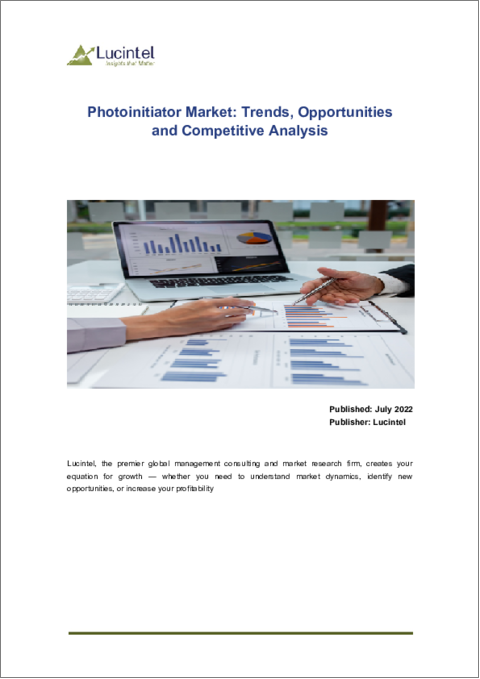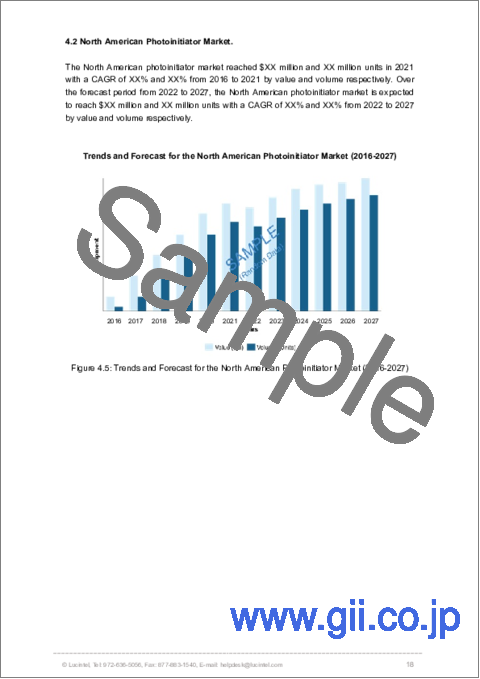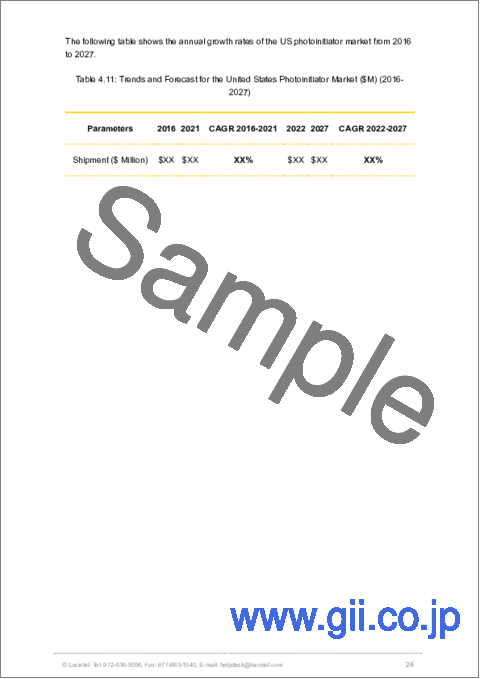|
|
市場調査レポート
商品コード
1079250
光重合開始剤市場:動向、機会、競合分析Photoinitiator Market: Trends, Opportunities and Competitive Analysis |
||||||
|
● お客様のご希望に応じて、既存データの加工や未掲載情報(例:国別セグメント)の追加などの対応が可能です。 詳細はお問い合わせください。 |
|||||||
| 光重合開始剤市場:動向、機会、競合分析 |
|
出版日: 2022年07月01日
発行: Lucintel
ページ情報: 英文 163 Pages
納期: 3営業日
|
- 全表示
- 概要
- 目次
光重合開始剤の市場規模は、2021年から2027年に8.2%のCAGRで成長し、2027年には16億米ドルになると予測されています。市場を牽引する主な要因には相対的な安定性や光の吸収範囲などの優れた特性による光重合開始剤の需要の増加などがあります。将来は紫外線硬化型コーティング剤、インク、接着剤において機会があるでしょう。
当レポートでは光重合開始剤の世界市場を調査し、市場規模や予測、市場の促進要因および課題、市場動向、セグメント別の市場分析、競合情勢、成長機会分析などの体系的な情報を提供しています。
目次
第1章 エグゼクティブサマリー
第2章 市場の背景と分類
- イントロダクション、背景、および分類
- サプライチェーン
- 業界の促進要因と課題
第3章 市場動向と予測分析(2016年~2027年)
- マクロ経済動向と予測
- 世界市場動向と予測
- 用途別
- 塗料
- インク
- 接着剤
- 製品タイプ別
- フリーラジカルタイプ
- カチオンタイプ
第4章 地域別の市場動向と予測分析
- 地域別
- 北米
- 用途別
- 製品タイプ別
- 米国
- カナダ
- メキシコ
- 欧州
- 用途別
- 製品タイプ別
- ドイツ
- 英国
- フランス
- アジア太平洋地域
- 用途別
- 製品タイプ別
- 中国
- インド
- 日本
- その他の地域
- 用途別
- 製品タイプ別
第5章 競合分析
- 製品ポートフォリオ分析
- 運用統合
- 地理的範囲
- ポーターのファイブフォース分析
第6章 成長機会と戦略分析
- 成長機会分析
- 用途別
- 製品タイプ別
- 地域別
- 世界市場における新たな動向
- 戦略分析
- 新製品の開発
- 合併、買収、合弁事業
第7章 主要企業のプロファイル
- IGM Resins
- Arkema S.A
- Tianjin Jiuri New Material Co. Ltd.
- Changzhou Tronly New Electronic Materials
- RAHN AG
Photoinitiator Market Trends and Forecast
The future of the global photoinitiator market looks promising with opportunities in UV cured coatings, inks, and, adhesives. The photoinitiator market is expected to reach an estimated $1.6 billion by 2027 and it is forecast to grow at a CAGR of 8.2% from 2021 to 2027. The major drivers for this market are increasing demand of photoinitiator due to its excellent properties like relative stability and range of light absorption.
Emerging Trends in the Photoinitiator Market
Emerging trends, which have a direct impact on the dynamics of the industry, include Improved performance of UV cured coating photoinitiators in the electronic assembly and advancement in light cure adhesive technology.
A total of 98 figures / charts and 69 tables are provided in this 163-page report to help in your business decisions. Sample figures with some insights are shown below. To learn the scope, benefits, companies researched, and other details of the global photoinitiator market report.
Photoinitiator Market by Segment
The study includes a forecast for the global photoinitiator market by application, product type, and region, as follows:
By Application [Volume (M lbs) and $M shipment analysis for 2016 - 2027]
- Paints
- Inks
- Adhesives
By Product Type [Volume (M lbs) and $M shipment analysis for 2016 - 2027]
- Free Radical Type
- Cationic Type
By RegionVolume [Volume (M lbs) and $M shipment analysis for 2016 - 2027]
- North America
- United States
- Canada
- Mexico
- Europe
- Germany
- United Kingdom
- France
- Asia Pacific
- China
- India
- Japan
- The Rest of the World
List of Photoinitiator Companies
Companies in the market compete on the basis of product quality offered. Major players in this market focus on expanding their manufacturing facilities, R&D investments, infrastructural development, and leverage integration opportunities across the value chain. With these strategies photoinitiator companies cater increasing demand, ensure competitive effectiveness, develop innovative products & technologies, reduce production costs, and expand their customer base. Some of the photoinitiator companies profiled in this report includes.
- GM Resins
- Arkema S.A
- Tianjin Jiuri New Material Co. Ltd.
- Changzhou Tronly New Electronic Materials
- RAHN AG
Photoinitiator Market Insight
- Lucintel forecasts that paint is expected to remain the largest application due to its increasing demand for UV cured wood coatings, automotive coatings, and powder coatings. Inks is expected to witness the highest growth over the forecast period due to increasing demand in printing, graphic arts, and LED ink curing.
- Free radical type will remain the largest product type segment and is expected to witness the highest growth over the forecast period supported by increase in demand of photoinitiator in various applications such as medical devices, electronic devices, glass, and others.
- Asia Pacific is expected to remain the largest region and it is also expected to witness highest growth over the forecast period due to increasing demand for photoinitiators in electronic, packaging, and automotive industries as it improves the overall productivity by reducing cure time and low VOC emissions.
Features of Photoinitiator Market
- Market Size Estimates: Photoinitiator market size estimation in terms of value ($M) and volume (M lbs) shipment.
- Trend and Forecast Analysis: Market trends (2016-2021) and forecast (2022-2027) by various segments and regions.
- Segmentation Analysis: Market size by application and product type in terms of value and volume.
- Regional Analysis: Photoinitiator market breakdown by North America, Europe, Asia Pacific, and the Rest of the World.
- Growth Opportunities: Analysis of growth opportunities in different application and product type and regions in terms of value and volume, for the photoinitiator market.
- Strategic Analysis: This includes M&A, new product development, and competitive landscape for the photoinitiator market.
- Analysis of competitive intensity of the industry based on Porter's Five Forces model.
FAQ
Q1. What is the photoinitiator market size?
Answer:The global photoinitiator market is expected to reach an estimated $1.6 billion by 2027
Q2. What is the growth forecast for photoinitiator market?
Answer:The photoinitiator market is expected to grow at a CAGR of 8.2% from 2021 to 2027.
Q3. What are the major drivers influencing the growth of the photoinitiator market?
Answer: The major drivers for this market are increasing demand of photoinitiator due to its excellent properties like relative stability and range of light absorption.
Q4. What are the major applications or end use industries for photoinitiator?
Answer:Paint is expected to remain the largest application due to its increasing demand for UV cured wood coatings, automotive coatings, and powder coatings.
Q5. What are the emerging trends in photoinitiator market?
Answer:Emerging trends, which have a direct impact on the dynamics of the industry, include improved performance of UV cured coating photoinitiators in the electronic assembly and advancement in light cure adhesive technology.
Q6. Who are the key photoinitiator companies?
Answer:Some of the key photoinitiator companies are as follows:
- GM Resins
- Arkema S.A
- Tianjin Jiuri New Material Co. Ltd.
- Changzhou Tronly New Electronic Materials
- RAHN AG
Q7. Which photoinitiator product segment will be the largest in future?
Answer: Lucintel forecasts that free radical type will remain the largest product type segment and is expected to witness the highest growth over the forecast period supported by increase in demand of photoinitiator in various applications such as medical devices, electronic devices, glass, and others.
Q8 : In photoinitiator market, which region is expected to be the largest in next 5 years?
Answer:Asia Pacific is expected to remain the largest region and witness the highest growth over next 5 years
Q9. Do we receive customization in this report?
Answer:Yes, Lucintel provides 10% Customization Without any Additional Cost.
This report answers following 11 key questions
- Q.1 What are some of the most promising potential, high-growth opportunities for the global photoinitiator market by application (paints, inks, and, adhesives), product type (free radical type and cationic type), and region (North America, Europe, Asia Pacific, and Rest of the World)?
- Q. 2 Which segments will grow at a faster pace and why?
- Q.3 Which regions will grow at a faster pace and why?
- Q.4 What are the key factors affecting market dynamics? What are the drivers and challenges of the market?
- Q.5 What are the business risks and threats to the market?
- Q.6 What are the emerging trends in this market and the reasons behind them?
- Q.7 What are the changing demands of customers in the market?
- Q.8 What are the new developments in the market? Which companies are leading these developments?
- Q.9 Who are the major players in this market? What strategic initiatives are being implemented by key players for business growth?
- Q.1 0 What are some of the competitive products and processes in this area and how big of a threat do they pose for loss of market share via material or product substitution?
- Q.1 1 What M & A activities have taken place in the last 5 years in this market?
Table of Contents
1. Executive Summary
2. Market Background and Classifications
- 2.1: Introduction, Background, and Classifications
- 2.2: Supply Chain
- 2.3: Industry Drivers and Challenges
3. Market Trends and Forecast Analysis from 2016 to 2027
- 3.1: Macroeconomic Trends and Forecast
- 3.2: Global Photoinitiator Market Trends and Forecast
- 3.3: Global Photoinitiator Market by Application
- 3.3.1: Paint
- 3.3.2: Ink
- 3.3.3: Adhesive
- 3.4: Global Photoinitiator Market by Product Type
- 3.4.1: Free Radical Type
- 3.4.2: Cationic Type
4. Market Trends and Forecast Analysis by Region
- 4.1: Global Photoinitiator Market by Region
- 4.2: North American Photoinitiator Market
- 4.2.1: Market by Application: Paint, Ink, and Adhesive
- 4.2.2: Market by Product Type:Free Radical Type and Cationic Type
- 4.2.3: United States Photoinitiator Market
- 4.2.4: Canadian Photoinitiator Market
- 4.2.5: Mexican Photoinitiator Market
- 4.3: European Photoinitiator Market
- 4.3.1: Market by Application: Paint, Ink, and Adhesive
- 4.3.2: Market by Product Type:Free Radical Type and Cationic Type
- 4.3.3: German Photoinitiator Market
- 4.3.4: United Kingdom Photoinitiator Market
- 4.3.5: French Photoinitiator Market
- 4.4: APAC Photoinitiator Market
- 4.4.1: Market by Application: Paint, Ink, and Adhesive
- 4.4.2: Market by Product Type:Free Radical Type and Cationic Type
- 4.4.3: Chinese Photoinitiator Market
- 4.4.4: Indian Photoinitiator Market
- 4.4.5: Japanese Photoinitiator Market
- 4.5: ROW Photoinitiator Market
- 4.5.1: Market by Application: Paint, Ink, and Adhesive
- 4.5.2: Market by Product Type:Free Radical Type and Cationic Type
5. Competitor Analysis
- 5.1: Product Portfolio Analysis
- 5.2: Operational Integration
- 5.3: Geographical Reach
- 5.4: Porter's Five Forces Analysis
6. Growth Opportunities and Strategic Analysis
- 6.1: Growth Opportunity Analysis
- 6.1.1: Growth Opportunities for the Global Photoinitiator Market by Application
- 6.1.2: Growth Opportunities for the Global Photoinitiator Market by Product Type
- 6.1.3: Growth Opportunities for the Global Photoinitiator Market by Region
- 6.2: Emerging Trends in the Global Photoinitiator Market
- 6.3: Strategic Analysis
- 6.3.1: New Product Development
- 6.3.2: Mergers, Acquisitions, and Joint Ventures in the Global Photoinitiator Market
7. Company Profiles of Leading Players
- 7.1: IGM Resins
- 7.2: Arkema S.A
- 7.3: Tianjin Jiuri New Material Co. Ltd.
- 7.4: Changzhou Tronly New Electronic Materials
- 7.5: RAHN AG




